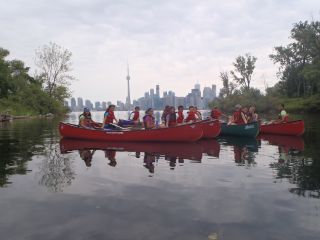Environment
All Kids Need Time in Nature and the Planet Needs That Too
Spending time outdoors helps every child thrive and the planet survive.
Posted April 23, 2023 Reviewed by Jessica Schrader
Key points
- Nature education is a good way to address growing concerns about young people's mental health and about environmental sustainability.
- Spending time outdoors can increase kids' health, happiness, curiosity, creativity, resilience, and engagement in environmental protection.
- Less privileged kids in dense urban environments are most in need of easy access to the natural world.

I’m writing this on Earth Day 2023, at a time when too many kids have deep worries about the future, and when most people realize that kids, communities, and the planet need more of the confidence, curiosity, and creativity that’s supported by time spent outdoors.
Young people who spend time in nature are smarter, happier, calmer, healthier, and less anxious than those who spend most of their time indoors. They’re more confident, more resilient, more curious, and more creative. They’re better at problem-solving, critical thinking, and leadership.
How Does Outdoor Time Support Children’s Best Development?
- Time in nature builds confidence and independence. Children who spend time outdoors feel freer. They have an enlarged sense of possibility, open-ended ways to interact with the environment, and a greater sense of control over their activities.
- Outdoor time encourages curiosity, imagination, and creativity. When kids are outside, they feel freer to invent their own activities. They’re motivated to explore the environment and think about ways to use it and move within it.
- Nature stimulates all the senses. When kids are immersed in the natural world, they’re more alert to the rich diversity of sounds, smells, tactile objects, and sights around them. There’s always the possibility of a surprise, something they hadn’t noticed before.
- Being outdoors encourages physical activity and health. When a child is outside, they’re almost always moving, strengthening their muscles, and stimulating their heart.
- Time spent in nature supports mental health and resilience. Children, teens, and adults who spend time in nature are calmer, happier, and better able to manage challenges and setbacks.
- Kids who spend time outside are better risk-takers. Outdoor activities give children the opportunity to take appropriate risks. In Outward Bound courses, for example, “there is the gradual transfer of initiative, which means that the instructor, who is very involved at the beginning of the courses, gradually withdraws and lets the students take the lead in order to increase their self-confidence and autonomy.”
- Knowing more about the natural world leads to environmental awareness and protection. Spending time in nature helps young people understand their place in the ecosystem, and the vulnerability and interdependence of all species. It increases the likelihood they’ll be part of the solution to climate change and environmental degradation, not part of the problem.
The Natural World and Equity
The more vulnerable a child, the more important it is they have opportunities to experience time in nature. Urban families with fewer resources are more likely to live in crowded neighborhoods and most in need of the rich benefits of nature. At the same time, they have a harder time getting out into natural settings. They’re less likely to live close to large parks or wilderness, and less likely to have the means to take holidays in nature or send their kids to nature camps.
What Can We Do to Ensure All Kids Have Access to Nature?
- Spend time in nature with the children in your life. Do your best to ensure that the young people in your life spend as much time outdoors as possible. Look for ways to make that happen in small ways and large, from walks in a local park to extended vacations in natural settings.
- Support or initiate local policy initiatives. In most jurisdictions, policy changes are needed to ensure that natural spaces are protected and made fully accessible to all members of the community.
- Support or initiate nature education as part of the school curriculum. Many private schools already offer opportunities for learning about and spending time in the natural world, but that’s not the case in far too many public education systems where the kids are most in need of spending time in nature. For the health, well-being, and resilience of individual children and the planet, nature education should be woven into the curriculum for every child, from kindergarten to the end of high school.
- Support organizations like Outward Bound and the National Wildlife Foundation. There are organizations that work to ensure better access to immersive nature experiences for all kids, including those from low-income and BIPoC families, and those who feel different than others. For example, Outward Bound is an international organization that provides financial support and full scholarships for a range of programs designed to give young people from all communities immersive outdoor experiences. It also works toward integrating experiential outdoor education into public schools. The National Wildlife Foundation has many programs designed to help young people get outside and learn about nature.
References


